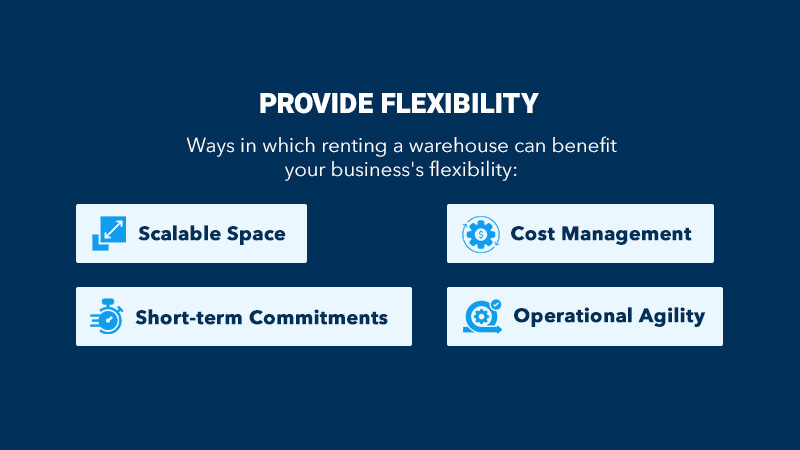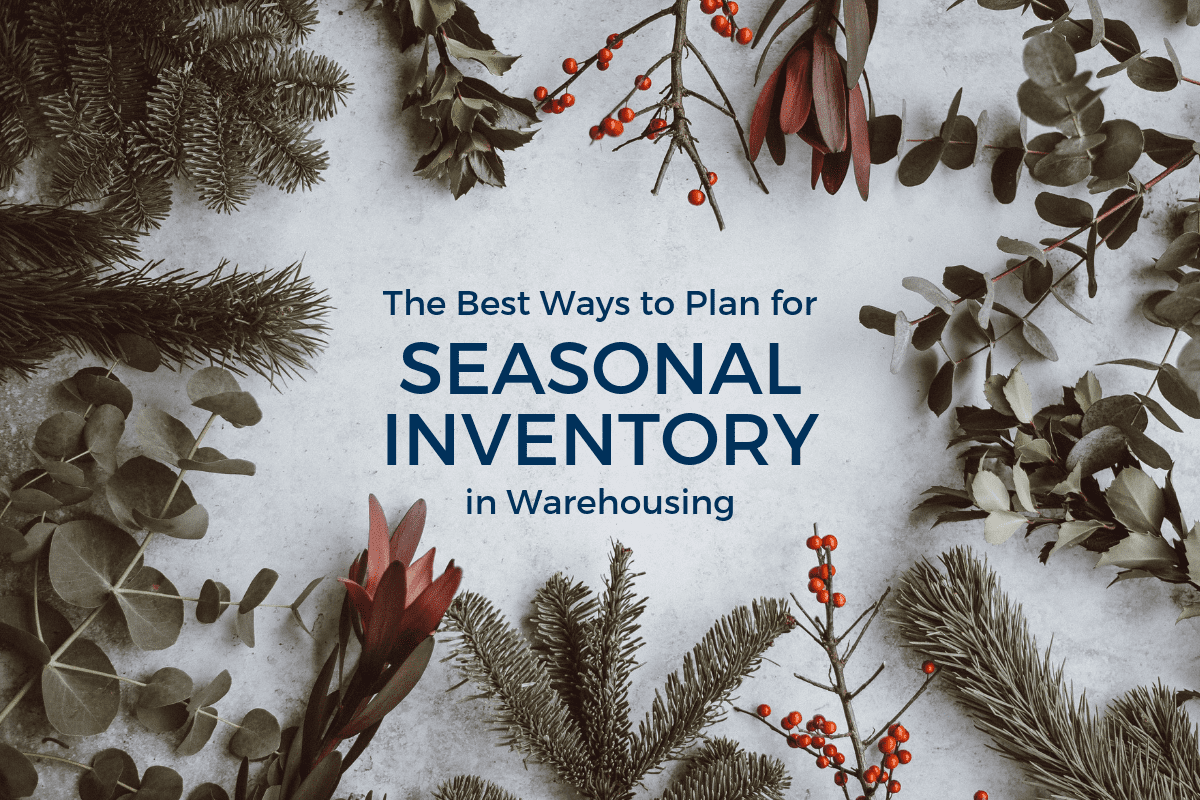Scaling up your operations effectively is essential for sustained business growth, and renting warehouse space can be a big game changer. Different businesses have unique needs regarding warehouse types, size and rental periods. Startups might require small, short-term rentals to test new markets, while established companies may benefit from larger, long-term leases to support steady growth.
By understanding the warehouse rental benefits and how they can enhance inventory management, order fulfillment and customer reach, you can make informed decisions that align with your business’s growth trajectory.
How Warehouse Rentals Boost Growth
In today’s fast-paced business environment, scaling up operations efficiently is crucial for sustained business growth. Renting warehouse space is an effective strategy that many business owners use. This approach offers many benefits that can significantly enhance operational capabilities.
By leveraging warehouse rentals, businesses can manage inventory more effectively, improve order fulfillment processes and expand their customer reach without the hefty upfront costs of purchasing property.
Additionally, renting provides the flexibility to adapt to changing market demands and business needs. The following sections delve into specific ways warehouse rentals can drive growth. Whether you’re a small business hoping to increase your size or a larger enterprise intending to optimize your current operations, understanding these advantages can help you make informed decisions about your warehousing needs.
1. Inventory Scalability
One of the benefits of warehouse rentals is that they offer a scalable solution for managing inventory, allowing your business to adjust to your storage needs based on current and future demands. This flexibility is particularly beneficial for companies that experience seasonal fluctuations or are experiencing rapid growth. The following are ways that warehouse rentals can enhance inventory scalability:
- Adjustable space: Only rent the space you need and seek rental agreements allowing changes. Whether you need a small area as a startup or a large facility as an expanding enterprise, renting gives you more flexibility than buying.
- Cost efficiency: You can avoid the significant capital expenditure of purchasing a warehouse. Instead, you can allocate those resources to other growth areas or increase inventory.
- Quick expansion: You can quickly increase the storage capacity during peak seasons or promotional periods without long-term commitments, particularly if you acquire short-term lease agreements.
- Reduced risk: Mitigate the risks associated with overstocking or understocking by easily scaling the storage space up or down as you need.
Leveraging different warehouse rental types and lease lengths can help your business maintain optimal inventory levels and ensure you are always well-positioned to meet customer demands without incurring unnecessary costs.
2. Improve Order Fulfillment
Optimizing the layout of a rental warehouse can significantly enhance your order fulfillment efficiency. A well-organized warehouse layout minimizes the time spent locating and picking items, directly translating to faster order processing and increased customer satisfaction. Some key strategies to implement include:
- Efficient picking paths: Design picking paths that minimize travel time. Group frequently ordered items together and place them in easily accessible locations.
- Vertical storage: If the ceiling height allows, use vertical space with high shelving. This will help maximize storage capacity without expanding the floor space you need.
- Clear labeling: Implement a robust labeling system and use different types of retrieval systems for your aisles and product locations to streamline the picking process.
Adapting the warehouse layout to meet specific business needs is also crucial. For instance, businesses can reconfigure layouts based on seasonal demand or product turnover rates. This flexibility will allow your warehouse to remain efficient and responsive to any changes in your operational requirements, improving order fulfillment and customer satisfaction.
3. Widen Customer Reach
Choosing the right warehouse location is pivotal for expanding your delivery range and widening your customer reach. Selecting the right location involves analyzing customer demographics, transportation infrastructure and rental costs. By optimizing these elements, you can ensure that your products reach more customers efficiently, which drives growth and expansion in the market. The following are ways the right location can widen your customer reach:
- Proximity to customers: A strategically located warehouse close to your target market reduces delivery times and shipping costs. By being near your customers, you can offer favorable delivery times. You can then provide same-day or next-day deliveries, which gives you a competitive edge.
- Access to transportation hubs: Warehouses near major highways, railroads, ports or airports often experience more efficient distribution. Being closer to these ensures you can transport goods more quickly and effectively. This ultimately enhances your ability to serve a much wider customer base promptly. It also helps reduce your transportation costs, which can quickly increase as you scale.
- Regional coverage: By having a rental warehouse in key regions, your business can cover more ground without overextending your resources. A regional approach enables you to offer greater service across various markets, widening your reach and increasing customer satisfaction.

4. Provide Flexibility
One of the advantages of renting warehouse space is that it offers your business the flexibility to manage and adapt to growth effectively. This flexibility is crucial for responding to market changes and scaling operations without the constraints of owning property. The following are ways in which renting a warehouse can benefit your business’s flexibility:
- Scalable space: You can easily adjust the amount of storage space based on your business’s current needs. This is particularly useful for companies with seasonal fluctuations or those experiencing rapid growth.
- Short-term commitments: Rental agreements often offer shorter and longer terms, and you have more flexibility than if you were to purchase. This allows your business to adapt quickly to changing circumstances without being locked into overly long-term commitments.
- Cost management: Renting avoids the significant upfront costs of purchasing a warehouse. This frees up capital for other growth areas and initiatives. This financial flexibility can be crucial for expanding product lines or entering new markets.
- Operational agility: You can quickly relocate your business to different warehouses as needed, ensuring you are always in the optimal location for your operations.
5. Design Factors
The design and structure of a warehouse, along with its amenities, play a crucial role in optimizing operations and supporting business growth. When selecting a warehouse, certain design factors must be considered to ensure the facility can support your current needs and scale with your business as it grows. Some areas to think about include:
- Layout efficiency: A well-designed layout facilitates a smooth workflow and ensures efficiency. This reduces the time and effort required for picking, packing and shipping. Consider open floor plans that allow for customization and easy movement of goods and equipment.
- Structural integrity: High ceilings and robust construction enable vertical storage solutions, ensure the floor load capacity can handle heavier stock and equipment, and help your operations run smoothly. A structurally sound warehouse is paramount to your operations as it can positively impact your workflow.
- Modern amenities: Features such as climate control, advanced integrated security systems and loading docks can enhance operational efficiency and protect inventory. Climate control is crucial for some businesses, such as those dealing with perishable goods and sensitive materials.
Short Term vs Long Term
Short-term leases, usually ranging from a few months to a year, offer flexibility for businesses experiencing seasonal demand or uncertain growth. They allow for quick adjustments in storage needs without long-term commitments, making them ideal for startups or businesses testing new markets.
Long-term leases, spanning several years, provide stability and often come with lower monthly rates. They suit established businesses with predictable storage needs and a clear growth trajectory. Long-term leases can also secure prime warehouse locations and offer opportunities for customization to fit a business’s operational requirements better.

Get Flexible Warehouse Options With RISE Commercial District
Now that you understand why you should rent warehouse space, consider the various warehouse options available from RISE Commercial District. We provide clean and professional warehouse facilities in several locations with an inclusive package that includes utilities, dumpsters, amenities, Wi-Fi and much more.
If you want to book a tour of our secure and flexible facilities or inquire about our offerings and available options, contact us today!



